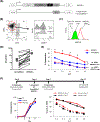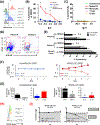NK Cells Expressing a Chimeric Activating Receptor Eliminate MDSCs and Rescue Impaired CAR-T Cell Activity against Solid Tumors
- PMID: 30651290
- PMCID: PMC7906796
- DOI: 10.1158/2326-6066.CIR-18-0572
NK Cells Expressing a Chimeric Activating Receptor Eliminate MDSCs and Rescue Impaired CAR-T Cell Activity against Solid Tumors
Abstract
Solid tumors are refractory to cellular immunotherapies in part because they contain suppressive immune effectors such as myeloid-derived suppressor cells (MDSCs) that inhibit cytotoxic lymphocytes. Strategies to reverse the suppressive tumor microenvironment (TME) should also attract and activate immune effectors with antitumor activity. To address this need, we developed gene-modified natural killer (NK) cells bearing a chimeric receptor in which the activating receptor NKG2D is fused to the cytotoxic ζ-chain of the T-cell receptor (NKG2D.ζ). NKG2D.ζ-NK cells target MDSCs, which overexpress NKG2D ligands within the TME. We examined the ability of NKG2D.ζ-NK cells to eliminate MDSCs in a xenograft TME model and improve the antitumor function of tumor-directed chimeric antigen receptor (CAR)-modified T cells. We show that NKG2D.ζ-NK cells are cytotoxic against MDSCs, but spare NKG2D ligand-expressing normal tissues. NKG2D.ζ-NK cells, but not unmodified NK cells, secrete proinflammatory cytokines and chemokines in response to MDSCs at the tumor site and improve infiltration and antitumor activity of subsequently infused CAR-T cells, even in tumors for which an immunosuppressive TME is an impediment to treatment. Unlike endogenous NKG2D, NKG2D.ζ is not susceptible to TME-mediated downmodulation and thus maintains its function even within suppressive microenvironments. As clinical confirmation, NKG2D.ζ-NK cells generated from patients with neuroblastoma killed autologous intratumoral MDSCs capable of suppressing CAR-T function. A combination therapy for solid tumors that includes both NKG2D.ζ-NK cells and CAR-T cells may improve responses over therapies based on CAR-T cells alone.
©2019 American Association for Cancer Research.
Conflict of interest statement
The authors declare no potential conflicts of interest.
Figures






Similar articles
-
Constitutive IL-7 signaling promotes CAR-NK cell survival in the solid tumor microenvironment but impairs tumor control.J Immunother Cancer. 2025 Jul 23;13(7):e010672. doi: 10.1136/jitc-2024-010672. J Immunother Cancer. 2025. PMID: 40707132 Free PMC article.
-
Human iPSC-derived NK cells armed with CCL19, CCR2B, high-affinity CD16, IL-15, and NKG2D complex enhance anti-solid tumor activity.Stem Cell Res Ther. 2025 Jul 15;16(1):373. doi: 10.1186/s13287-025-04461-9. Stem Cell Res Ther. 2025. PMID: 40660312 Free PMC article.
-
Ammonia Suppresses the Antitumor Activity of Natural Killer Cells and T Cells by Decreasing Mature Perforin.Cancer Res. 2025 Jul 2;85(13):2448-2467. doi: 10.1158/0008-5472.CAN-24-0749. Cancer Res. 2025. PMID: 40163355 Free PMC article.
-
Designs of NKG2D-based immunotherapeutics for cancer.Front Immunol. 2025 Jun 19;16:1557644. doi: 10.3389/fimmu.2025.1557644. eCollection 2025. Front Immunol. 2025. PMID: 40612946 Free PMC article. Review.
-
Effects of Mesenchymal Stem Cells on Functions of Chimeric Antigen Receptor-Expressing T Lymphocytes and Natural Killer Cells.Cells. 2025 Jun 25;14(13):978. doi: 10.3390/cells14130978. Cells. 2025. PMID: 40643499 Free PMC article. Review.
Cited by
-
Poliovirus receptor-based chimeric antigen receptor T cells combined with NK-92 cells exert potent activity against glioblastoma.J Natl Cancer Inst. 2024 Mar 7;116(3):389-400. doi: 10.1093/jnci/djad226. J Natl Cancer Inst. 2024. PMID: 37944044 Free PMC article.
-
Flattening the COVID-19 Curve With Natural Killer Cell Based Immunotherapies.Front Immunol. 2020 Jun 23;11:1512. doi: 10.3389/fimmu.2020.01512. eCollection 2020. Front Immunol. 2020. PMID: 32655581 Free PMC article. Review.
-
CAR-NK cells for cancer immunotherapy: recent advances and future directions.Front Immunol. 2024 Feb 9;15:1361194. doi: 10.3389/fimmu.2024.1361194. eCollection 2024. Front Immunol. 2024. PMID: 38404574 Free PMC article. Review.
-
Activated NK cells reprogram MDSCs via NKG2D-NKG2DL and IFN-γ to modulate antitumor T-cell response after cryo-thermal therapy.J Immunother Cancer. 2022 Dec;10(12):e005769. doi: 10.1136/jitc-2022-005769. J Immunother Cancer. 2022. PMID: 36521929 Free PMC article.
-
Upregulation of CD3ζ and L-selectin in antigen-specific cytotoxic T lymphocytes by eliminating myeloid-derived suppressor cells with doxorubicin to improve killing efficacy of neuroblastoma cells in vitro.J Clin Lab Anal. 2022 Jan;36(1):e24158. doi: 10.1002/jcla.24158. Epub 2021 Dec 3. J Clin Lab Anal. 2022. PMID: 34861064 Free PMC article.
References
-
- Thistlethwaite FC, Gilham DE, Guest RD, Rothwell DG, Pillai M, Burt DJ, Byatte AJ, Kirillova N, Valle JW, Sharma SK, et al. The clinical efficacy of first-generation carcinoembryonic antigen (CEACAM5)-specific CAR T cells is limited by poor persistence and transient pre-conditioning-dependent respiratory toxicity. Cancer immunology, immunotherapy : CII. 2017;66(11):1425–36. - PMC - PubMed
Publication types
MeSH terms
Substances
Grants and funding
LinkOut - more resources
Full Text Sources
Other Literature Sources
Research Materials

